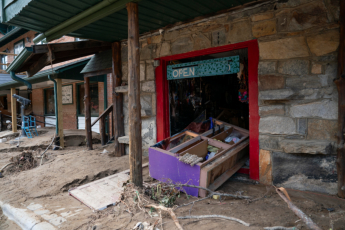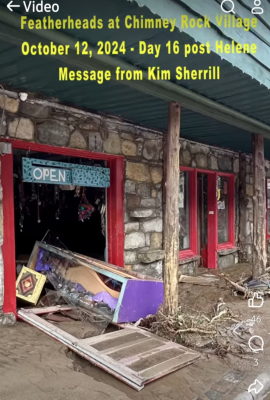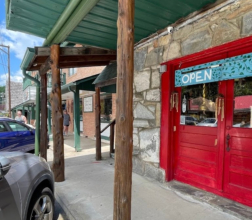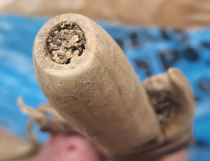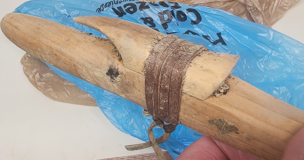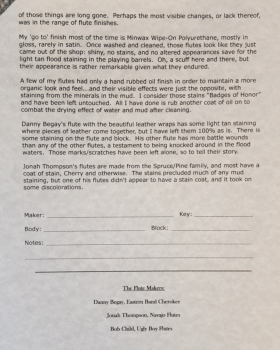Meteorologicaly, the perfect storm set up shop in the North Carolina mountains on
Wednesday September 27, 2024. A stalled frontal boundary in east Tennessee and
a low pressure cell on the front’s tail in Arkansas gave hours of moderate to heavy
rainfall to the NC mountains. The copious rain saturated the soils and was causing
waters to rise even if just a little.
All that had nothing to do with Hurricane Helene.
Helene’s remnants arrived along that frontal boundary by Thursday night and
through Friday. The resulting carnage and devestation was one for the record
books. “Apocalyptic” is warranted in several areas.
This is
but one small account in possibly one the hardest hit
areas:
Chimney Rock Village, just above Lake Lure. The
Rocky
Broad River became a liquid buzzsaw and literally
wiped
away roads, houses, bridges, and numerous businesses.
Featherheads is constructed of thick-walled riverstone
on the
hill side of the lone road through the village and
spared
what those across the street on the river side had to
watch wash away. The owner, Kim Sherrill, had lived above the store for many
years, but one month prior to the floods had bought a house further down in the
Foothills. Upon her initial guided return days later, she was given just one precious
hour at Featherheads.
Miraculously, she pulled out 19 flutes to take back to her house. This was a one-of-
a-kind chance to see just how flood waters and mineral-rich muds affected these
flutes. Kim and I have been good friends for close to 20 years. I arranged to pick
up the flutes and take them to my shop to further clean and go over each flute,
checking for any damage and what else I might find. I really didn’t know what to
expect. Of the 19 flutes, two were by Danny Begay (Eastern Band Cherokee), six
were by Jonah Thompson (Navajo Flutes), and the remaining eleven were my Ugly
Boys. She may have found more by now, but this is the story of the 19.
Before I get into the details, let me be clear that in honor and respect to the other
flute makers, I made no adjustments to their tuning and voices. In a few cases,
nests had to be flattened from warping, and most if not all of the blocks needed
flattening due to the water’s effects, but that was the extent of any alterations.
Many had nicks/scrapes/stains that I refer to as “Badges of Honor” and all were left
as-is. More details on that as you read on.
The first step was to continue the cleaning. Kim had washed most of the mud off of
most of the flutes, but the barrels and SACs needed further cleaning via pressured
water. I then used sandpaper on a stick to get out the more stubborn organic
deposits. Some blocks were off the flutes and while there was a small pile of
leather ties, only a few of those were usable. All three of us makers have a unique
block style, so it was easy to put them with their respective flutes. Per Jonah’s
flutes, I could only guess which got the eagle, the ram, the wolf, etc. They were all
of identical proportions, including the nests.
This one Shadow Hawk of mine, a B4, came bagged and provided a good idea of of
its condition as found, after being knocked around in the flood. FYI, my Shadow
Hawks have only oil coats and are made from Poplar and Spruce:
This B4 Shadow Hawk came full of debris. I first removed what I could with various
tools before using a bit of pressured water to clean out any other loose material.
The barrels were simple to do, while the SACs (slow air chambers) were more
problematic. Once cleaned and fully dried, I used sandpaper on a stick to further
get out leftover soil adhered to the chambers.
NOTE: all flutes show the light tan dust/stain inside the barrels and SAC, though I
did run a pipe cleaner with butcher block type oil in every mouthpiece to seal any
leftover dust for precautions sake. Below: this is how the flute turned out…and
give a listen to just how beautiful the post-flood, untouched voice is:
Further notes on what I found/discovered with the flutes:
Finishes: My go-to finish for the majority of my flutes is Minwax Wipe-On Poly I
get at Lowes. Most get 3-5 coats depending on the need. Those flutes cleaned up
looking like they just left my shop, rather pristine excepting the prevalent light tan
coating in the interior surfaces. That’s a heckuva endorsement on just how tought
that finish is. Most impressive.
For some flutes, I felt like they would do better and look/feel more organic with a
couple of hand-rubbed oil coats. Those flutes took on some mineral staining,
depending on how much mud and for how long the flute stayed in it.
Perhaps the most amazing comparison between those two finishes was almost a
fluke in that she had two Ugly Boys in the same unusual wood, each finished
differently. One of the flutes was a C5 in Papua New Guinea Walnut, a light tan,
open grained wood that is easily worked. It had a wipe-on poly finish. She also had
an A4 in Papua New Guinea Walnut that I had decided to use the oil finish instead.
The latter took on extensive staining (including the Walnut block), given it’s
lengthy burial in the mineral-rich mud….providing a stark contrast between the
two, insofar as appearances. Their untouched, post-flood voices are amazingly
intact:
Voices and Pitches: Wood soaked in water is going to swell some, and while the
outside of flutes have some sort of finish or stain that helps lessen that effect, most
flutes don’t have finish on their interior surfaces, except maybe an oil coat. The
only flutes to exhibit a minor change on the exterior were the Navajo Flutes, which
are all made of a Spruce/Pine family wood. The grain rose some, giving the flutes a
textured feel, but a rather pleasant feel. The interior of his barrel shows a fair
amount of swelling (that type of wood swells more than others in water), which
does nothing more than alter the pitch.
Speaking of pitch, as I tested each one just to have a key to put on the certificate
I’ve made for each one, almost all of them are not exactly on pitch. For example,
one flute was blowing at 30-40 cents sharp, while another one only 10-20 cents
sharp. A few were pretty darn close to pitch but individual notes may have been off
a tad with swelling from the wood surface inside the playing hole.
One of my overall intentions was not to alter these flutes in any way to change
pitches and tuning. Their provenance is as they are now and should be respected
and
honored in that way. In my
humble opinion, anyway. :-)
Nest
and Block Conditions: Air
leaking in the nest area, either
from
a non-flat nest or non-flat block
bottom, affects the quality of
the
voice being produced. Several
nests
were warped but easily
flattened, and almost all of the
blocks needed flattening, as
well.
Easily accomplished, and for
both
nests and block bottoms I
simply rubbed a little butcher
block oil to the raw surfaces. For the Navajo flutes, given their wood type, they
needed a rubbed in oil coat to counter the drying and swelling affect from being
soaked in water for so long. I did the same for my oil finished Shadow Hawks and
Ugly Boys. I don’t know how Danny finishes his flutes, but they didn’t look or feel
‘dry’.
For each flute I created a certificate of sorts that details the story overall as well
as details specific to that flute.Click on an image to enlarge (for that matter, click
on any pic in here to enlarge!) I had already printed up these certificates before I
realized I had put two special flood flutes in a diferent area of the shop, making for
19 recovered flutes, not 17. More on that below… And so last Saturday I made the
trek to the TIEC listed below, off Exit 170 on Hgy 74 near Mill Sprin, North
Carolina. It is a sprawling facility, originally designed for top flight horse shows,
but has expanded its offerings in myriad other ways. The International Pavillion is
where the Chimney Rock stores destroyed by the floods have set up their
impromptu shops, thanks to the generosity of TIEC. I went and played flutes for
about two hours, telling the story of the recovered flutes to anyone interested. At
some point I asked Kim what other flutes she recovered, as I know I had some bass
flutes there, as well.
None. Not another one. These 19 are the sole survivors:
Bob Child (Ugly Boy Flutes)
Danny
Begay (Eastern Band Cherokee)
Johan
Thompson (Navajo Flutes)


Meteorologicaly, the perfect storm set up shop in the North Carolina mountains on
Wednesday September 27, 2024. A stalled frontal boundary in east Tennessee and a
low pressure cell on the front’s tail in Arkansas gave hours of moderate to heavy
rainfall to the NC mountains. The copious rain saturated the soils and was causing
waters to rise even if just a little.
All that had nothing to do with Hurricane Helene.
Helene’s remnants arrived along that frontal boundary by Thursday night and
through Friday. The resulting carnage and devestation was one for the record books.
“Apocalyptic” is warranted in several areas.
This is but one small account in possibly one the hardest hit
areas: Chimney Rock Village, just above Lake Lure. The
Rocky Broad River became a liquid buzzsaw and literally
wiped away roads, houses, bridges, and numerous
businesses. Featherheads is constructed of thick-walled
riverstone on the hill side of the lone road through the
village and spared what those across the street on the river
side had to watch wash away. The owner, Kim Sherrill, had
lived above the store for many years, but one month prior to the floods had bought a
house further down in the Foothills. Upon her initial guided return days later, she
was given just one precious hour at Featherheads.
Miraculously, she pulled out 19 flutes to take back to her house. This was a one-of-a-
kind chance to see just how flood waters and mineral-rich muds affected these flutes.
Kim and I have been good friends for close to 20 years. I arranged to pick up the
flutes and take them to my shop to further clean and go over each flute, checking for
any damage and what else I might find. I really didn’t know what to expect. Of the
19 flutes, two were by Danny Begay (Eastern Band Cherokee), six were by Jonah
Thompson (Navajo Flutes), and the remaining eleven were my Ugly Boys. She may
have found more by now, but this is the story of the 19.
Before I get into the details, let me be clear that in honor and respect to the other
flute makers, I made no adjustments to their tuning and voices. In a few cases, nests
had to be flattened from warping, and most if not all of the blocks needed flattening
due to the water’s effects, but that was the extent of any alterations. Many had
nicks/scrapes/stains that I refer to as “Badges of Honor” and all were left as-is. More
details on that as you read on.
The first step was to continue the cleaning. Kim had washed most of the mud off of
most of the flutes, but the barrels and SACs needed further cleaning via pressured
water. I then used sandpaper on a stick to get out the more stubborn organic
deposits. Some blocks were off the flutes and while there was a small pile of leather
ties, only a few of those were usable. All three of us makers have a unique block
style, so it was easy to put them with their respective flutes. Per Jonah’s flutes, I
could only guess which got the eagle, the ram, the wolf, etc. They were all of
identical proportions, including the nests.
This one Shadow Hawk of mine, a B4, came bagged and provided a good idea of of its
condition as found, after being knocked around in the flood. FYI, my Shadow Hawks
have only oil coats and are made from Poplar and Spruce:
This B4 Shadow Hawk came full of debris. I first removed what I could with various
tools before using a bit of pressured water to clean out any other loose material. The
barrels were simple to do, while the SACs (slow air chambers) were more
problematic. Once cleaned and fully dried, I used sandpaper on a stick to further get
out leftover soil adhered to the chambers.
NOTE: all flutes show the light tan dust/stain inside the barrels and SAC, though I
did run a pipe cleaner with butcher block type oil in every mouthpiece to seal any
leftover dust for precautions sake. Below: this is how the flute turned out…and give
a listen to just how beautiful the post-flood, untouched voice is:
Further notes on what I found/discovered with the flutes:
Finishes: My go-to finish for the majority of my flutes is Minwax Wipe-On Poly I get
at Lowes. Most get 3-5 coats depending on the need. Those flutes cleaned up looking
like they just left my shop, rather pristine excepting the prevalent light tan coating
in the interior surfaces. That’s a heckuva endorsement on just how tought that finish
is. Most impressive.
For some flutes, I felt like they would do better and look/feel more organic with a
couple of hand-rubbed oil coats. Those flutes took on some mineral staining,
depending on how much mud and for how long the flute stayed in it.
Perhaps the most amazing comparison between those two finishes was almost a fluke
in that she had two Ugly Boys in the same unusual wood, each finished differently.
One of the flutes was a C5 in Papua New Guinea Walnut, a light tan, open grained
wood that is easily worked. It had a wipe-on poly finish. She also had an A4 in Papua
New Guinea Walnut that I had decided to use the oil finish instead. The latter took
on extensive staining (including the Walnut block), given it’s lengthy burial in the
mineral-rich mud….providing a stark contrast between the two, insofar as
appearances. Their untouched, post-flood voices are amazingly intact:
Voices and Pitches: Wood soaked in water is going to swell some, and while the
outside of flutes have some sort of finish or stain that helps lessen that effect, most
flutes don’t have finish on their interior surfaces, except maybe an oil coat. The only
flutes to exhibit a minor change on the exterior were the Navajo Flutes, which are all
made of a Spruce/Pine family wood. The grain rose some, giving the flutes a textured
feel, but a rather pleasant feel. The interior of his barrel shows a fair amount of
swelling (that type of wood swells more than others in water), which does nothing
more than alter the pitch.
Speaking of pitch, as I tested each one just to have a key to put on the certificate I’ve
made for each one, almost all of them are not exactly on pitch. For example, one
flute was blowing at 30-40 cents sharp, while another one only 10-20 cents sharp. A
few were pretty darn close to pitch but individual notes may have been off a tad with
swelling from the wood surface inside the playing hole.
One of my overall intentions was not to alter these flutes in any way to change
pitches and tuning. Their provenance is as they are now and should be respected and
honored in that way. In my humble opinion, anyway. :-)
Nest and Block Conditions: Air leaking in the nest area, either from a non-flat nest or
non-flat block bottom, affects the quality of the voice being produced. Several nests
were warped but easily flattened, and almost all of the blocks needed flattening, as
well. Easily accomplished, and for both nests and block bottoms I simply rubbed a
little butcher block oil to the raw surfaces. For the Navajo flutes, given their wood
type, they needed a rubbed in oil coat to counter the drying and swelling affect from
being soaked in water for so long. I did the same for my oil finished Shadow Hawks
and Ugly Boys. I don’t know how Danny finishes his flutes, but they didn’t look or
feel ‘dry’.
For each flute I created a
certificate of sorts that details the
story overall as well as details
specific to that flute.Click on an
image to enlarge (for that matter,
click on any pic in here to
enlarge!) I had already printed up
these certificates before I realized
I had put two special flood flutes
in a diferent area of the shop,
making for 19 recovered flutes,
not 17. More on that below… And
so last Saturday I made the trek to
the TIEC listed below, off Exit 170
on Hgy 74 near Mill Sprin, North
Carolina. It is a sprawling facility, originally designed for top flight horse shows, but
has expanded its offerings in myriad other ways. The International Pavillion is where
the Chimney Rock stores destroyed by the floods have set up their impromptu shops,
thanks to the generosity of TIEC. I went and played flutes for about two hours,
telling the story of the recovered flutes to anyone interested. At some point I asked
Kim what other flutes she recovered, as I know I had some bass flutes there, as well.
None. Not another one. These 19 are the sole survivors:
Bob Child (Ugly Boy Flutes)
Danny Begay (Eastern Band Cherokee)
Jonah Thompson (Navajo Flutes)
11/16/24 follow-up: TIEC is a sprawling complex now,
developing into a truly resort-like experience built
primarily around the top-tier equestrian events
internationally. The pavillion where the Chimney Rock
Village store owners were given storefronts is a
wonderful open space perfect for the impromptu shops
set up for the holiday shopping season. All are located
on the 2nd floor, and at the entrance there is the
Chimney Rock Village sign that is at the bottom of the
picture on the left. The before and after picture of that
area was widely posted on the internet….I put a red
rectangle around the sign to give you an idea of just
how cataclysmic the flooding was to this hamlet (click
to enlarge). Other flood-ravaged areas will
be joining in by the arrival of Winterfest,
I’m told. Click HERE for more. I’ll be
adding a few more pictures from my visit in
a
couple of days. As a side note, who
remembers O. Henry’s “The Gift of the
Magi”? That’s kinda sorta what happened,
though there wasn’t the dramatic irony
involved. I wanted to surprise Kim and
took her two branch flutes for her to sell
and keep the proceeds…and she had wanted
to gift me the very one of the recovered
flutes of mine that ran deep in my Soul, the stained
A4 in Papua New Guinea Walnut. There is just
something about that flute that is ‘other than’ to me.
I’ll be going back to play at their store a few more
times as my schedule permits…and that precious one
will be a teacher to those that want to hear the story.
The Clean-up: Words don’t do justice….
-
(this update added 5/25) As I mentioned in the ‘news’ section
earlier, I recently got the heart-breaking news that Kimberly made
the tough decision to not rebuild/reopen Featherheads due to
severe financial constraints that could not be surmounted, and she
closed her presence in the Main Street consortium at the Tryon
Internation Equestrian Center a couple of months ago. Her store
still had good bones, though, and she is leasing it out to another
business that lost their building in the flood.
What’s ahead? I have no idea…for now, life rolls on for all of us and
I’ll post with any updates as I hear about ‘em.
“
UPCOMING: SATURDAY DECEMBER 7,2024

